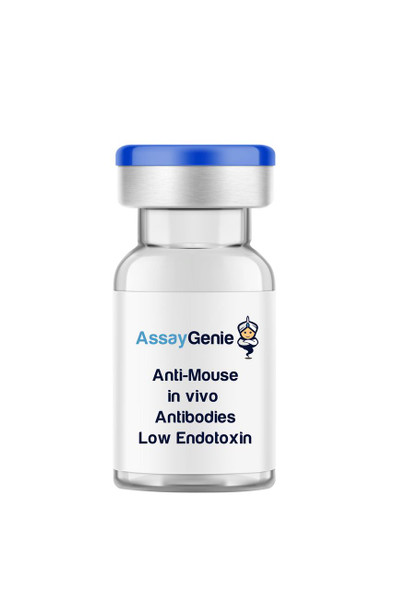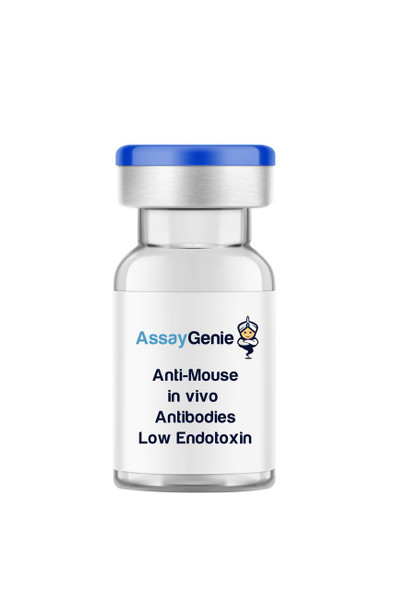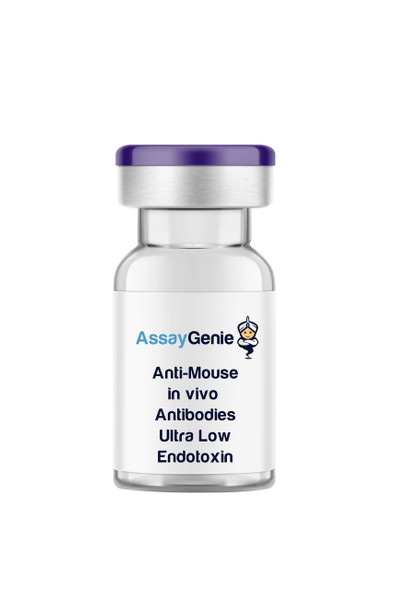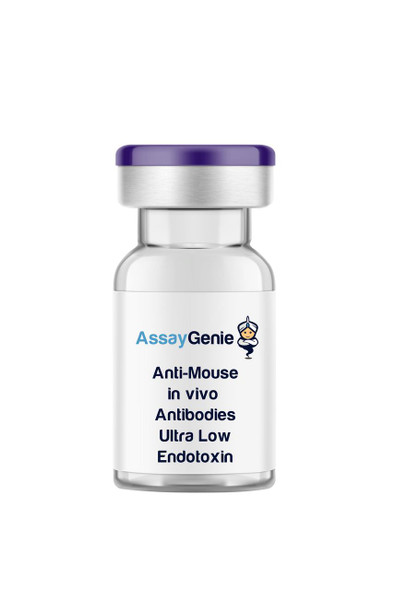Anti-Mouse PD-L2 (CD273) In Vivo Antibody - Ultra Low Endotoxin
- SKU:
- IVMB0115
- Product Type:
- In Vivo Monoclonal Antibody
- Clone:
- 3.2.B8
- Protein:
- PD-L2
- Isotype:
- Mouse IgG1
- Reactivity:
- Mouse
- Human
- Synonyms:
- B7-DC
- CD273
- PDL2
- B7DC
- Clone 3.2
- Research Area:
- Immune Checkpoint & Cancer Biology
- Endotoxin Level:
- Ultra Low Endotoxin
- Host Species:
- Mouse
- Applications:
- Blocking
- FC
- WB
Description
| Product Name: | Anti-Mouse PD-L2 (CD273) In Vivo Antibody - Ultra Low Endotoxin |
| Product Code: | IVMB0115 |
| Size: | 1mg, 5mg, 25mg, 50mg, 100mg |
| Clone: | 3.2.B8 |
| Protein: | PD-L2 |
| Product Type: | Monoclonal Antibody |
| Synonyms: | B7-DC, CD273, PDL2, B7DC, Clone 3.2 |
| Isotype: | Mouse IgG1 |
| Reactivity: | Mouse/Human |
| Immunogen: | Made in PD-L2 knockout mouse fusion partner X63-Ag8.653 myeloma cells |
| Applications: | B, FC, WB |
| Formulation: | This monoclonal antibody is aseptically packaged and formulated in 0.01 M phosphate buffered saline (150 mM NaCl) PBS pH 7.2 - 7.4 with no carrier protein, potassium, calcium or preservatives added. |
| Endotoxin Level: | <0.5 EU/mg as determined by the LAL method |
| Purity: | ≥98% monomer by analytical SEC >95% by SDS Page |
| Preparation: | Functional grade preclinical antibodies are manufactured in an animal free facility using only In vitro protein free cell culture techniques and are purified by a multi-step process including the use of protein A or G to assure extremely low levels of endotoxins, leachable protein A or aggregates. |
| Storage and Handling: | Functional grade preclinical antibodies may be stored sterile as received at 2-8°C for up to one month. For longer term storage, aseptically aliquot in working volumes without diluting and store at -80°C. Avoid Repeated Freeze Thaw Cycles. |
| Applications: | B, FC, WB |
| Recommended Usage: | WB For Western blot analysis at a concentration of 1.0-2.0 µg/ml when used in conjunction with compatible secondary reagents Each investigator should determine their own optimal working dilution for specific applications. See directions on lot specific datasheets, as information may periodically change. |
| Reactivity: | Mouse/Human |
| Host Species: | Mouse |
| Specificity: | Clone 3.2.B8 recognizes an epitope on mouse/human PD-L2 and has been shown to bind to both mouse and human PD-L2 equally well |
| Antigen Distribution: | PD-L2 is expressed on dendritic cells, liver, few transformed cell lines, and a subset of macrophages. |
| Immunogen: | Made in PD-L2 knockout mouse fusion partner X63-Ag8.653 myeloma cells |
| Concentration: | ≥ 5.0 mg/ml |
| Endotoxin Level: | <0.5 EU/mg as determined by the LAL method |
| Purity: | ≥98% monomer by analytical SEC >95% by SDS Page |
| Formulation: | This monoclonal antibody is aseptically packaged and formulated in 0.01 M phosphate buffered saline (150 mM NaCl) PBS pH 7.2 - 7.4 with no carrier protein, potassium, calcium or preservatives added. |
| Preparation: | Functional grade preclinical antibodies are manufactured in an animal free facility using only In vitro protein free cell culture techniques and are purified by a multi-step process including the use of protein A or G to assure extremely low levels of endotoxins, leachable protein A or aggregates. |
| Storage and Handling: | Functional grade preclinical antibodies may be stored sterile as received at 2-8°C for up to one month. For longer term storage, aseptically aliquot in working volumes without diluting and store at -80°C. Avoid Repeated Freeze Thaw Cycles. |
PD-1 is a 50-55 kD member of the B7 Ig superfamily. PD-1 is also a member of the extended CD28/CTLA-4 family of T cell regulators and is suspected to play a role in lymphocyte clonal selection and peripheral tolerance. The ligands of PD-1 are PD-L1 and PD-L2, and are also members of the B7 Ig superfamily. PD-1 and its ligands negatively regulate immune responses. PD-L1, or B7-Homolog 1, is a 40 kD type I transmembrane protein that has been reported to costimulate T cell growth and cytokine production. The interaction of PD-1 with its ligand PD-L1 is critical in the inhibition of T cell responses that include T cell proliferation and cytokine production. PD-L1 has increased expression in several cancers. Inhibition of the interaction between PD-1 and PD-L1 can serve as an immune checkpoint blockade by improving T-cell responses In vitro and mediating preclinical antitumor activity. Within the field of checkpoint inhibition, combination therapy using anti-PD1 in conjunction with anti-CTLA4 has significant therapeutic potential for tumor treatments. PD-L2 is a 25 kD type I transmembrane ligand of PD-1. Via PD-1, PD-L2 can serve as a co-inhibitor of T cell functions. Regulation of T cell responses, including enhanced T cell proliferation and cytokine production, can result from mAbs that block the PD-L2 and PD-1 interaction.
| Technical Datasheet: | View |
| Protein: | PD-L2 |
| Function: | Binds to PD-1 and alternative receptor |
| Ligand/Receptor: | PD-1 |
| Research Area: | Costimulatory Molecules, Immunology |

| Mouse IgG1 Isotype Control [HKSP84] | |
|---|---|
| Clone | HKSP84 |
| Isotype | Mouse IgG1 |
| Endotoxin Level | Ultra Low Endotoxin |
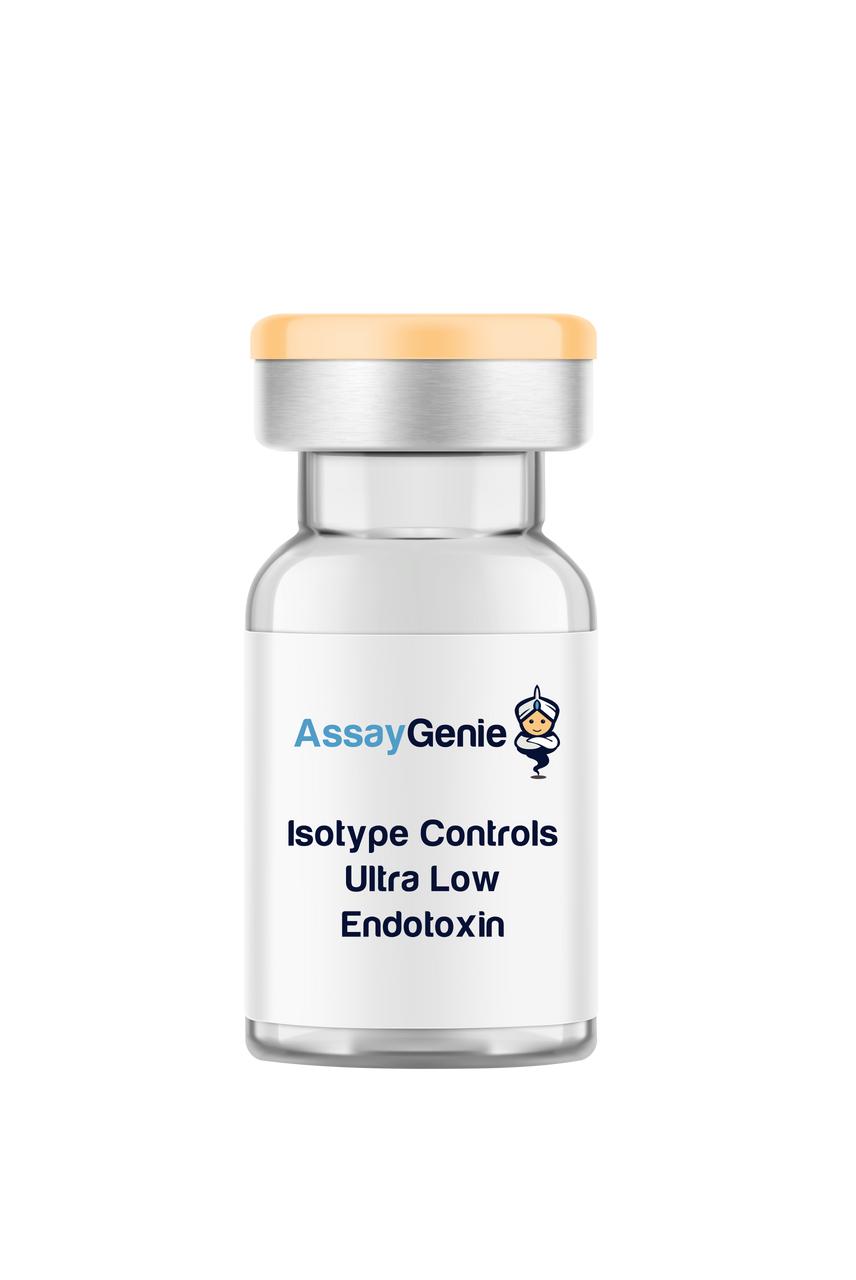
| Mouse IgG1 Isotype Control [HKSP] | |
|---|---|
| Clone | HKSP |
| Isotype | Mouse IgG1 |
| Endotoxin Level | Ultra Low Endotoxin |
Meet the team!
Shane Costigan
Territory Manager & Team Lead
Abdul Khadim
Sales Executive


